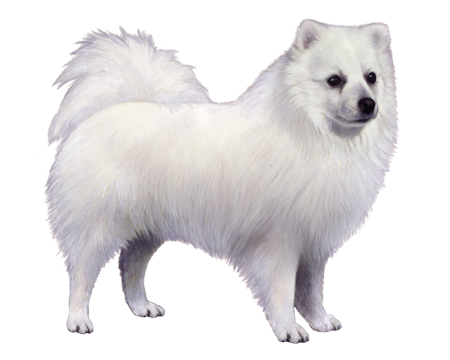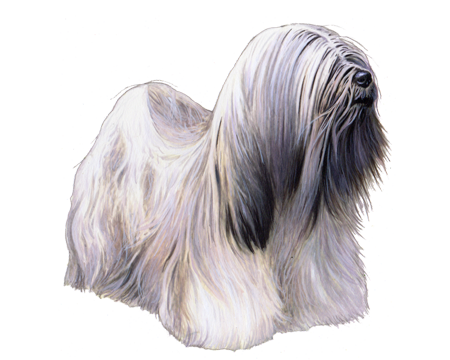
American Eskimo Dog
The American Eskimo Dog is active, outgoing, and quick to learn new tasks. With a playful nature and eager-to-please personality, Eskies make excellent (and adorable) four-legged family members.
Interested in discovering if your dog is an American Eskimo Dog?
Check out Wisdom Panel's DNA tests.

American Eskimo Dog Traits
General Appearance
This small-to-medium-sized Nordic dog has a compact, balanced build, erect, triangular-shaped ears, and thick white hair. American Eskimo Dogs come in three sizes: toy, miniature, and standard. All varieties have a smooth gait and keen, alert expression.
Coat and Colouring
The American Eskimo Dog has a stand-off double coat with a dense undercoat and longer outer coat with no curl or wave. A pronounced ruff around the neck, short, smooth hair around the muzzle, and significant feathering on the legs are hallmarks of the breed. Eskies have two possible coat colors: white or white with biscuit cream.
Distinctive Physical Traits
The American Eskimo is longer than it is tall. The breed has a deep chest, broad back, muscular loins, triangular, blunt-tipped ears, and slightly oval eyes. Its lips, nose, and eye rims form distinctive black points on its white face.
American Eskimo Dog Temperament
The American Eskimo Dog is a natural performer and quick to learn. However, this breed can also be conservative and guarded in unfamiliar situations or with unknown people. Eskies may be small, but they have big barks. They alert their people to a stranger's arrival, but Eskies are never aggressive or threatening. The breed can be vocal and might not be the best option for apartment life.
Due to their quick, curious natures, Eskies need a lot of exercise and mental stimulation. A quick walk around the block is not enough to satisfy their desire to explore. Providing American Eskimo Dogs with a fenced yard to roam and lots of different toys to play with can help channel their energy in positive directions. Without adequate stimulation, the breed can become bored and destructive.
Eskies form strong relationships with their owners. They are kid-friendly canines that are happiest spending time with their people. Keep these pups engaged by playing games of fetch or teaching them new tricks.


American Eskimo Dog History
You might be surprised to know that the American Eskimo does not actually hail from Arctic climates. Instead, German immigrants living in the American Midwest developed the breed. Though once known as the German Spitz, this breed's name changed to reflect anti-German sentiment in the United States during World War I.
American Eskimo Dogs served on the farm as herders, hunters, guardians, and companions. But the fun-loving breed also found fame performing tricks in traveling circuses and vaudeville troops. In the 1930s, an American Eskimo Dog named Pierre made headlines and captured hearts as a tightrope walker with the Barnum & Bailey Circus.
American Eskimo Dog Care
Nutrition
American Eskimo Dogs need a high-quality dog food that's appropriate for their life stage (e.g., puppy, adult, senior). A diet specially formulated for small breeds is a good option to consider. To help them stay at a healthy weight, measure out meals to avoid overfeeding, and make sure treats contribute to no more than 10% of your dog's daily calories.
Grooming
Though their sleek white coats are easy to maintain, Eskies are constant shedders. Brushing an American Eskimo Dog several times per week can help remove dead hair and prevent matting. Professional grooming is not required, but a decent vacuum is.
Avoid bathing your Eskie too often. Their skin has natural oils that repel dirt, and frequent bathing can dry out their skin, making it itchy and irritated.
All dogs require regular dental care—including at-home teeth brushing and professional dental cleanings. Maintaining good dental hygiene is essential for your pup's overall long-term health. So, it's best to start during puppyhood to make it a lifelong habit.
Exercise
American Eskimo Dogs have boundless energy. In addition to taking regular walks, consider signing your Eskie up for dog sports—such as agility, flyball, or musical canine freestyle (a sport that incorporates obedience, tricks, and dance). Mental stimulation is important, too. Teach your pup new tricks or offer puzzle toys to satisfy their curious natures.
These dogs tend to slow down as they get older, and middle-aged Eskies will require less exercise than younger pups.
Training
It's no surprise that American Eskimo Dogs excelled as circus performers. Among the most trainable breeds, Eskies quickly master basic commands and can learn much more complicated tricks (like walking a tightrope).
The breed is so smart that it will often pick up behaviors just from watching other dogs—and that's not always a good thing. Get a jump start on training to ensure this eager-to-please breed is channeling its focus positively. Untrained or under-socialized Eskies can develop behavior problems and might be destructive.
American Eskimo Dogs crave the companionship of their people. So, focus on training activities that promote interaction. Also, use positive reinforcement—such as praise and treats—to reward them for a job well done. Prioritizing socialization can also help your dog when among new people, pets, and surroundings.
American Eskimo Dog Genetic Health Conditions
-
Chondrodystrophy (CDDY) and Intervertebral Disc Disease (IVDD) Risk
Chondrodystrophy (CDDY) is a skeletal disorder characterized by shortened limbs and abnormal early degeneration of the spinal discs, or intervertebral disc disease (IVDD), which predisposes to disc herniation.
-
Thrombopathia (Discovered in the Eskimo Spitz)
Thrombopathia is an inherited bleeding disorder characterized by recurrent nosebleeds, bleeding of the gums, and bruising easily. The associated genetic variant has been identified in the Eskimo Spitz.
Knowing if your American Eskimo Dog is a carrier or at-risk for these conditions can help you and your veterinarian plan for your pup's lifelong care. With Wisdom Panel™ Premium, you can get results for over 200 genetic health tests.
Breed Group
Companion
This group consists of dogs typically bred for the specific purpose of human companionship, and many are popular pets because of their gentle nature. They became more common as the concept and luxury of dogs as pets prevailed.
Resources
https://www.akc.org/dog-breeds/american-eskimo-dog/
http://images.akc.org/pdf/breeds/standards/AmericanEskimoDog.pdf
Reviewed 26 July 2020 by Laura Inman, DVM



























_Color.png)




















